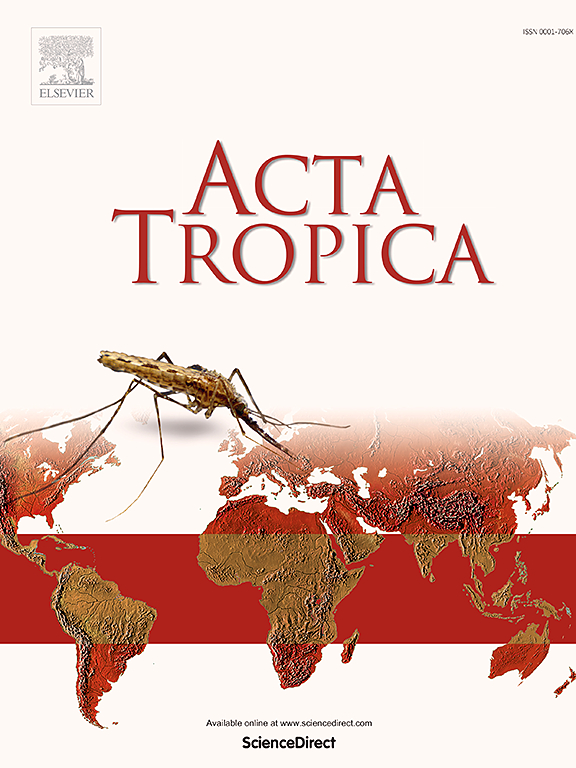泌尿生物标志物和血尿作为泌尿生殖器血吸虫病的指标:一项系统综述和荟萃分析。
IF 2.5
3区 医学
Q2 PARASITOLOGY
引用次数: 0
摘要
背景:血吸虫病是一种在热带地区导致慢性疾病和社会经济挑战的寄生虫感染。成年血吸虫寄生于膀胱静脉丛,产卵引起组织炎症和全身性病变,可作为尿液、血液和血清等体液中的尿液生物标志物检测到。尿液分析提供了一种快速、经济、无创的评估血吸虫病相关尿液生物标志物的方法。目的:本系统综述旨在确定指示血链球菌感染的尿液生物标志物并评估其诊断相关性。方法:系统检索PubMed、EbscoHost和谷歌Scholar等数据库,查找撒哈拉以南非洲地区使用即时检测试油尺检测泌尿生殖血吸虫病尿液生物标志物的研究。从699项筛选研究中,有19项符合纳入标准。这些研究的重点是所有年龄组的即时照护量尺使用情况,不包括使用实验室方法的人群。使用Joana Briggs质量评估工具对选定的文章进行评估,并创建详细的叙述性摘要。荟萃分析评估了研究的可变性。结果:血尿和蛋白尿是诊断尿路血吸虫病感染的关键尿标志物。荟萃分析发现血尿、蛋白尿、白细胞尿、硝酸盐、胆红素和尿胆素原的总患病率具有统计学意义。在测量血尿、蛋白尿、白细胞尿和硝酸盐(超过80%)的研究中观察到显著的异质性,硝酸盐的异质性较低(39.3%),但仍不显著。结论:血尿、蛋白尿、白细胞尿是泌尿生殖道血吸虫发病的指标;然而,为了提高诊断精度,有必要进一步研究测量与血吸虫病发病率直接相关的代谢物浓度。本文章由计算机程序翻译,如有差异,请以英文原文为准。

Urinary biomarkers and haematuria as indicators of urogenital schistosomiasis: A systematic review and meta-analysis
Background
Schistosomiasis, is a parasitic infection that leads to chronic illness and socioeconomic challenges in tropical regions. Adult Schistosoma (S.) haematobium worms inhabit the bladder's venous plexus and produce eggs that cause tissue inflammation and systemic pathologies, detectable as urinary biomarkers in bodily fluids like urine, blood, and serum. Urinalysis offers a rapid, cost-effective, non-invasive assessment of schistosomiasis-related urinary biomarkers.
Objectives
This systematic review aimed to identify urinary biomarkers indicative of S. haematobium infections and assess their diagnostic relevance.
Methods
A systematic search was conducted in databases including PubMed, EbscoHost, and Google Scholar to find studies on urogenital schistosomiasis urinary biomarkers detected by point-of-care dipsticks in sub-Saharan Africa. From 699 screened studies, 19 met the inclusion criteria. These studies focused on point-of-care dipstick use for all age groups, excluding those using laboratory-based methods. The Joana Briggs quality assesment tool was used to evaluate the selected articles, and a detailed narrative summary was created. A meta-analysis assessed study variability.
Results
The analysis identified haematuria and proteinuria as key urinary markers for diagnosing urinary schistosomiasis infections. The meta-analysis found a statistically significant pooled prevalence for haematuria, proteinuria, leukocyturia, nitrates, bilirubin, and urobilinogen. Significant heterogeneity was observed in studies measuring haematuria, proteinuria, leukocyturia, and nitrates (over 80 %), with lower but still non-significant heterogeneity for nitrates (39.3 %).
Conclusion
Haematuria, proteinuria and leukocyturia are indicators of urogenital schistosomiais morbidity; nonetheless, further investigation is necessary to measure metabolite concentrations directly associated with schistosomiasis morbidity for improved diagnostic precision.
求助全文
通过发布文献求助,成功后即可免费获取论文全文。
去求助
来源期刊

Acta tropica
医学-寄生虫学
CiteScore
5.40
自引率
11.10%
发文量
383
审稿时长
37 days
期刊介绍:
Acta Tropica, is an international journal on infectious diseases that covers public health sciences and biomedical research with particular emphasis on topics relevant to human and animal health in the tropics and the subtropics.
 求助内容:
求助内容: 应助结果提醒方式:
应助结果提醒方式:


